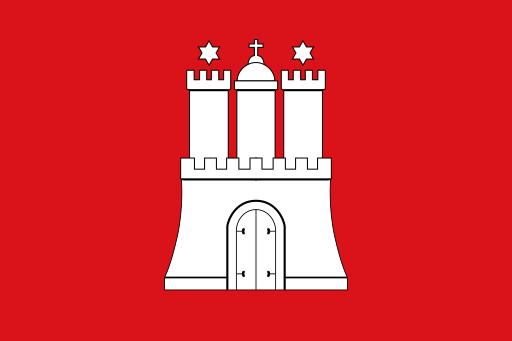A Brief History Of The German Flag Posted by Constanze on May 8, 2017 in Culture, Language
The German flag, with its black, red and gold stripes, is one of the most easily recognisable flags in the world. In this post, I’ll give you some information about the origins of the current flag, and show you some of its variations throughout history.
The Holy Roman Empire 962–1806

By David Liuzzo, eagle by N3MO (Own work) [CC BY-SA 3.0 (http://creativecommons.org/licenses/by-sa/3.0)], via Wikimedia Commons
Known in German as the Heiliges Römisches Reich, this pre-Germany state used a banner (not an official flag) featuring a black eagle with a red beak and red claws, on a yellow background. Its colours influenced the German flag as we know it today.
The German Empire 1871-1918

By User:B1mbo and User:Madden (Recoloured Image:Flag of Germany (2-3).svg) [Public domain], via Wikimedia Commons
Die Bundesflagge – The German national flag 1919-1933 (and 1949-present day)
The German flag as we know it today first came about in 1919 during the Weimar Republic, after Germany’s defeat in World War I. The black, red and gold colours used by the Holy Roman Empire are back, intended to symbolise a united, democratic Germany. The colours themselves (Schwarz-Rot-Gold) were mocked by far-right groups for the gold’s slightly ‘off’ colour. They called the flag ‘Schwarz-Rot-Senf’ (‘Black-Red-Mustard’) or ‘Schwarz-Rot-Scheiße’ (‘Black-Red-Shit’).
Nationalsozialistische Deutsche Arbeiterpartei (NSDAP or Nazi Party) flag 1933-1945
When the Nazi (National Sozialist) Party seized power in 1933, they made their Party flag the national flag of Germany. This featured a red background, a white circle, and a black Swastika (Hakenkreuz) in the middle. The red colour symbolised the socialist, the white symbolised the nationalist, and the Hakenkreuz the victory of the Aryan peoples.
A divided Germany (1949 – 1989)

East German flag (1959). By Flaggenentwurf: unbekannt diese Datei: Jwnabd [Public domain], via Wikimedia Commons
German state flags
As well as the national flag, each German state has its own flag, which you’ll see when you visit these states. Here are a couple of them:
Bavaria:
Berlin:
Hamburg:
So there you have a brief history of the German flag. Of course, there are more variants and flags than those listed here, but this post would’ve gone on forever had I listed them all! I think you’ll agree that it’s amazing how much you can learn about a country from its flag alone!
Bis bald,
Constanze

Build vocabulary, practice pronunciation, and more with Transparent Language Online. Available anytime, anywhere, on any device.









Comments:
Tom Dawkes:
There is a very good discussion of the German flags in Neil McGregor’s podcasts Germany: memories of a nation. The podcast 1848: The People’s Flag and Karl Marx at http://www.bbc.co.uk/programmes/b04k6rm5 is available to hear and download.
The text is available in McGregor’s accompanying book, published by Penguin in 2014 [isbn 97801419799786]
Constanze:
@Tom Dawkes Thank you, Tom! I’ll listen to that over lunch! 🙂
Monica Emy:
Thank you so much . I really like stories about Germany. My grandparents, both paternal and maternal. came to the USA from Germany. I like the flag bc of that reason and also bc happy since the unification. Thanks again for a great history of the German flag, may it stay this way for ever. Monica
Raúl:
Fascinating!!! Thank you very much for the post
Constanze:
@Raúl You’re welcome!
Joseph T. Madawela:
fun with flags!
Alexis Klug:
Wow, this was really cool! I was wondering though, wasn’t Prussia part of Germany at one point?